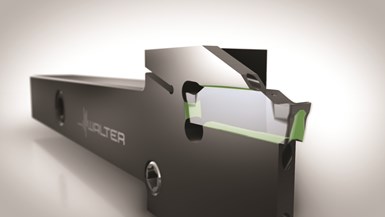Walter Cut DX18 Inserts for Grooving, Parting Off
Insert’s new geometries are designed to improve tool life, process reliability and cycle times.

Walter Cut DX18 insert in grooving tool holder system. Photo Credit: Walter
Walter’s Cut DX18 double-edged grooving and parting off inserts come in insert widths of 0.059 to 0.157" (1.5-4 mm) and are seated in the insert pocket with a prismatic design. This insert seating is designed to substantially eliminate the tendency for vibrations, thereby increasing insert life as well as toolholder life.
The design is also said to prevent incorrect engagement (especially for narrow insert widths) and enable high indexing accuracy. An elevated protective edge is an inbuilt feature which is said to protect the clamping finger of the toolholder from chip wash and act as an additional chipbreaker.
The DX18 geometries include the “C” cutoff geometries CF6, CF5 and CE4 for cut off (parting off). The “G” grooving geometries include GD6 and GD3 for grooving. The “U” universal geometries are UF4, UD4 and UAfor groove turning, parting off and grooving. The UD4 is said to act as a unique troubleshooter to achieve improved chip control. The “R” full-radius geometries for copy turning and radius grooving include the sintered RF7.
The holders for these inserts are made for Swiss-type machines as well as conventional lathe and bar-feeder machines. The holders are offered in both the signature precision-cooling, through coolant configuration as well as external coolant configuration for economies. The G4014-P holders are designed for Swiss machines, enabling inserts to be indexed while on the machine gang tooling, thereby reducing insert indexing. The G4011 holders are offered for conventional lathes in both square shank and Capto-style designs, while the G4041 blade-style holders are well suited for parting off close to shoulders in a limited space.
Related Content
-
The Ins and Outs of Inserts
Understanding how inserts are made provides valuable insight into how their performance can be optimized.
-
Repeatability and Rigidity Are Key for Quick-Change Swiss Tooling
A rotary wedge clamping system is said to enable this two-piece, modular tooling system for Swiss-types to offer the performance of a solid tool.
-
Data Matrix Codes Offer Cutting Tool Traceability
A company’s quest to discover errors in a manufacturing process has led to printing data matrix codes on its cutting tools that provide a wealth of information for both the user and this cutting tool manufacturer.













